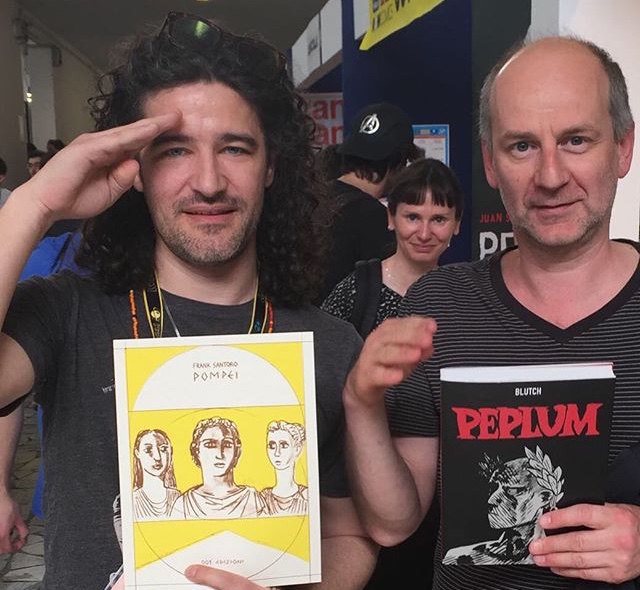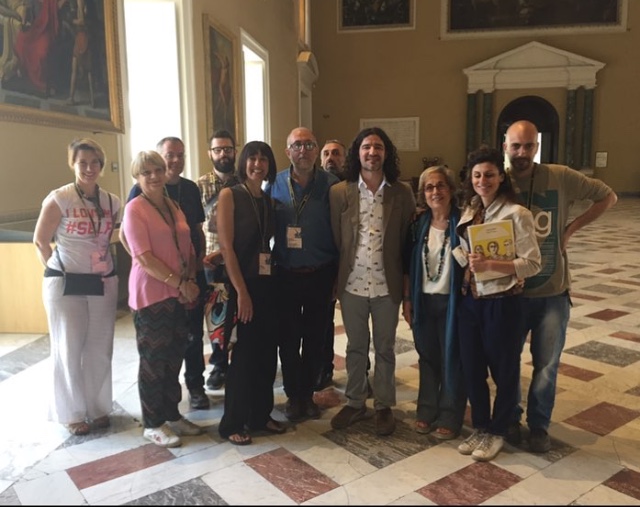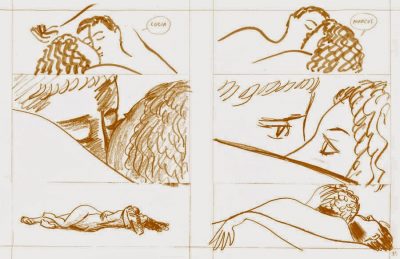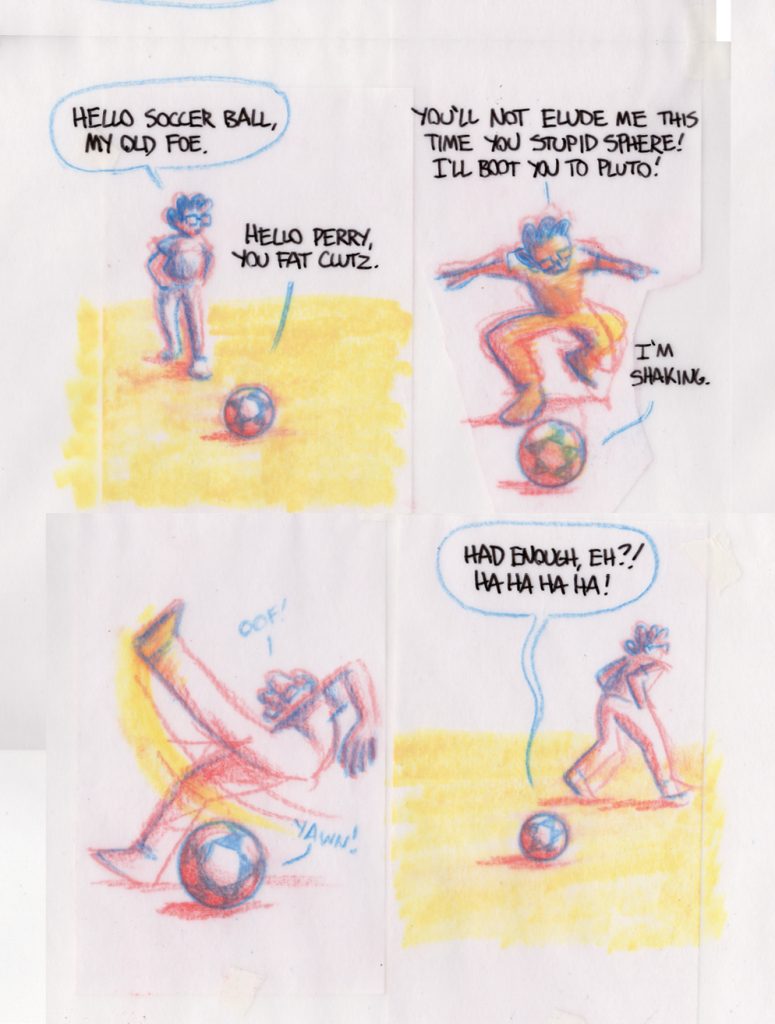Sally here with a roundup of reviews and commentary on Frank Santoro’s “Pompei”, which was published in Italy in May 2018 by 001 Edizioni!
———————————————————————————
Frank Santoro‘s Pompeii (PictureBox, 2013) was published in Italy in 2018 by 001 Edizioni. Pompei was released during the Naples Comicon (April 28-May 1 2018) where Frank was a special guest. In addition, an exhibition of original artwork from Pompei was held at the Archeological Museum of Naples from April 18-May 31 2018. More about that exhibition can be found HERE.


Several Italian critics, comics makers, and fans have written about Pompei since the release of the comic in Italy. Valerio Stivè, who translated Pompei for 001 Edizioni, was kind enough to translate those reviews into English for us. We present them here for you, with links to the original Italian publications where appropriate.
The Afterward for the 001 Edizioni edition of Pompei was written by Manuele Fior (translated from Italian here by Valerio Stivè).
If my personal library was threatened by a the eruption of a volcano, Pompeii by Frank Santoro is among the few books I would save.
The subject of this graphic novel is drawing; drawing the living, that are drawn while they draw, and drawing the dead, who, hugging each other, become drawings. Here, the lines mix up, multiplying the levels of reading, and we don’t know if what we see is a face on paper, on canvas, or on a mural painting.
The book is about drawing, and its ability to seduce, to distract from death, to imagine a future, and to establish an eternal testimony.
There are no second thoughts in Frank’s line, no rubber strokes, only shameless immediacy that offers itself to the reader in its most direct essence, full of errors and clumsiness. This is the best and only way to express the unique strength of some of his compositions, of the raw sensuality of flesh, and especially, of the most necessary of all, the love between two people.
This is a graphic novel that, for its intensity, I can never read in one breath. I have to stop, with shivers on my back, and reach for my heart.
This is a book that looks like it was drawn on a stone dug up from the ashes, to which time has erased colors and details, while preserving the deeply human living trace of the intentions of this great cartoonist. – Manuele Fior
Daniele Barbieri‘s review of Pompei was originally published on Fumettologica on May 5th 2018. Valerio Stivè translates it from Italian below (with sections in bold retained from Barbieri’s original piece):
The idea of narrating a historic event through the personal events of a single fictional character in order to let the reader/spectator empathize with the story and understand the events – then comprehending History in a much deeper way than reading a History book – is not new. In literary fiction, as well as in cinema and comics, that is a common and effective narrative device, as long as the reader is able to understand it. Our present times can become the present of those events (despite the historical and cultural differences); and an every day life that we recognize as familiar suddenly fades into something totally different: the historic event itself.
If limited to this, Pompeii by Frank Santoro could be seen as a story like many others, maybe more delicate and emotive. Yet there already are so many tales of the last days of Pompeii, even similar to this…
The thing is that there is so much more in here. From the very first pages, even before one could figure out where the story would go, the drawing looks rapid, approximative; almost like a sketch or a storyboard – where the imperfect lines are not erased, but adjusted, leaving the imperfection in plain site. No colours, obviously, just some quick textures for the shadows, with an overall sense of temporariness and instability.
Then, the story starts to take shape: Marcus, the main character, is an assistant to a painter who is probably going to become famous and move to Rome. Marcus prepares his colours and helps him with the paintings, while forced to be complicit in the painter’s affair with a princess, that needs to be kept hidden from Alba, his suspicious partner. Marcus has a woman too, Lucia, with whom he left Paestum, where he has no intention to come back: he wants to become a portrait painter in Pompeii – just like his master – to make money and start a family with Lucia.
This is the picture of everyday affections and little tensions on which the eruption of the Vesuvius occurs. Obviously, the event leaves everyone astonished. However, Marcus encourages the painter to draw that shocking event right away (while it still has to fully take place). “You can add it to the landscape commission! You’ll be the first to paint the gods in action!” he says. The idea of drawing, which was there since the beginning of the story – but, before this, only in the work of the painter – now becomes more and more relevant.
Please read the complete review in English HERE.
Francesco Boille wrote about Pompei for Internazionale – you can see the magazine article in Italian above. Valerio Stivè translates it into English below.
Pompeii fluidly tells a story of happy every day life of two couples from different social backgrounds, before the apocalypse that happened in August of the year 79 B.C. Santoro uses almost unfinished images that remind us of so many things from the History of Art, from cave painting onwards. He focuses on the act of drawing rather than on the act of painting – as Manuele Fior points out in his afterword – which “offers itself to the reader in its most direct essence”. This serves as a metaphor of the fact that images are only shadows, ghosts of the past, just like every one of us will be someday. Sketches of life and sketches of drawings are mixed up, and Santoro reverses the intense petrified physicality of the molds produced from human bodies in Pompeii into a totally lighter dimension. Looks like Frank Santoro, in contrast to the caducity of all things, is showing that the idea of how the strength of poetry expresses itself at best in its most ethereal form, as a unique way to go beyond time and space. To the cold and conceptual approach of most of American graphic novels, Santoro prefers a European approach, based on a free, soft and aerial line. Redesigned in a such a personal way. He comes up with a masterpiece of poetry in its most pure form, a masterpiece about the idea of poetry itself; and he does that while putting together frail and incomplete fragments of an artistic greatness that once was.
– Francesco Boille, for Internazionale May 2018
Simona Di Rosa wrote a review of Pompei for FuoriPosto on May 23rd 2018. Valerio Stivè translates it from Italian into English below.
Premiered at Napoli COMICON, Pompeii – a graphic novel published by 001 Edizioni from Torino – is written and drawn by Frank Santoro, and set in Pompeii a few days before the eruption that destroyed the city. The book – a large softcover edition – was published in collaboration with COMICON and the Archeological Museum of Naples, which until May 31st will be hosted an exhibition of original artwork from the book.
Frank Santoro resides in Pittsburgh, where he manages artists’ residencies hosting and helping fellow cartoonists. He is not well known in Italy, and yet he is among the most original voices in contemporary avant garde American comics scene, thanks to Pompeii, published in the USA five years ago. Santoro has an artisanal approach to comics making, using poor tools – mostly pencils and markers – perfect to tell a story set in the ancient Pompeii, showing its historic value while supporting a touching plot, deeply touching despite the unavoidable outcome.
Please read the complete review in English HERE.
Get a copy of Pompeii by Frank Santoro in English from Copacetic Comics – HERE!
Also, be sure to check out Frank’s new book, the stunning Pittsburgh (Éditions çà et là, May 2018 – currently available in French only!) You can read more about the book HERE.
———————————————————————————
Joanie and Jordie – 6-14-18 – by Caleb Orecchio




